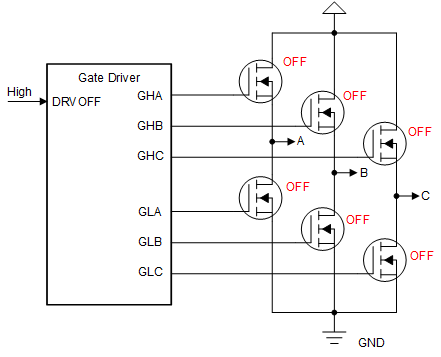SLVSHC7 December 2023 DRV8334
PRODUCTION DATA
- 1
- 1 Features
- 2 Applications
- 3 Description
- 4 Revision History
- 5 Pin Configuration and Functions
- 6 Specification
-
7 Detailed Description
- 7.1 Overview
- 7.2 Functional Block Diagram
- 7.3
Feature Description
- 7.3.1 Three BLDC Gate Drivers
- 7.3.2 Low-Side Current Sense Amplifiers
- 7.3.3 Gate Driver Shutdown
- 7.3.4
Gate Driver Protective Circuits
- 7.3.4.1 PVDD Supply Undervoltage Lockout (PVDD_UV)
- 7.3.4.2 GVDD Undervoltage Lockout (GVDD_UV)
- 7.3.4.3 BST Undervoltage Lockout (BST_UV)
- 7.3.4.4 MOSFET VDS Overcurrent Protection (VDS_OCP)
- 7.3.4.5 VSENSE Overcurrent Protection (SEN_OCP)
- 7.3.4.6 Phase Comparators
- 7.3.4.7 Thermal Shutdown (OTSD)
- 7.3.4.8 Thermal Warning (OTW)
- 7.3.4.9 OTP CRC
- 7.3.4.10 SPI Watchdog Timer
- 7.4 Device Functional Modes
- 7.5 Programming
- 7.6 Register Maps
- 8 Application and Implementation
- 9 Layout
- 10Device and Documentation Support
- 11Mechanical, Packaging, and Orderable Information
Package Options
Mechanical Data (Package|Pins)
- PHP|48
Thermal pad, mechanical data (Package|Pins)
- PHP|48
Orderable Information
7.3.3.1 DRVOFF Gate Driver Shutdown
When DRVOFF is driven high, the gate driver goes into shutdown mode, overriding signals on inputs pins INHx and INLx. DRVOFF bypasses the internal digital logic and is connected directly to the predriver. This pin provides a mechanism for externally monitored faults to disable the gate driver directly bypassing the external controller. When the DRVOFF pin is driven high, the device disables the gate driver and triggers the shutdown sequence.
 Figure 7-14 DRVOFF Gate Driver Output
State
Figure 7-14 DRVOFF Gate Driver Output
State